Family name: Orchidaceae Jussieu
Synonym(s): Apostasiaceae Lindl., nom. cons.; Cypripediaceae Lindl.; Limodoraceae Horan.; Neuwiediaceae R. Dahlgren ex Reveal & Hoogland; Vanillaceae Lindl.
Common name(s): orchid family
*Number of genera/species: 736/28,000
List of genera records in GRIN-Global
fruit or seed
Fruit a septicidalsepticidal:
type of capsular dehiscence, opening longitudinally by separating between the septa of adjacent carpels
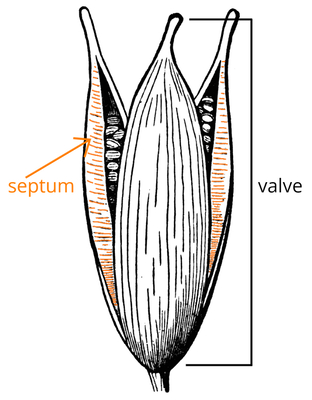 or loculicidalloculicidal:
or loculicidalloculicidal:
type of capsular dehiscence, opening longitudinally through the locules (compare septicidal)
 capsulecapsule:
capsulecapsule:
a dry, dehiscent fruit derived from a compound ovary , opening by three or six slits, rarely a berry (species of Vanilla, Galeola, Palmorchis, Rhizanthella), 3–270 mm long, fusiformfusiform:
, opening by three or six slits, rarely a berry (species of Vanilla, Galeola, Palmorchis, Rhizanthella), 3–270 mm long, fusiformfusiform:
spindle-shaped; broadest at the middle and tapering at both ends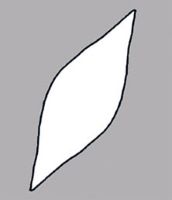 to trigonoustrigonous:
to trigonoustrigonous:
3D shape—having three faces that meet at distinct angles; triangular in outline
, tereteterete:
approximately circular in cross section; width and thickness approximately equal
 or angledangular:
or angledangular:
2D shape—having sides that meet at acute or obtuse angles
in transection, often sulcatesulcate:
surface relief—having one or more elongate, relatively narrow and shallow depressions or grooves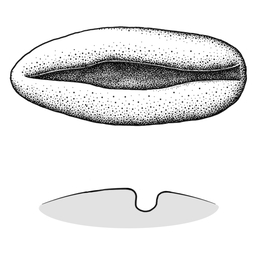 , sometimes winged or beakedbeak:
, sometimes winged or beakedbeak:
a usually firm, terminal appendage, sometimes tapered , stylestyle:
, stylestyle:
in a flower, the narrow and elongated part of the pistil between the stigma and the ovary; sometimes persisting in fruit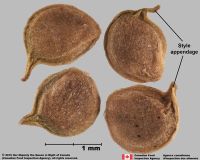 persistent, sometimes perianthperianth:
persistent, sometimes perianthperianth:
collective term for calyx and corolla of a flower
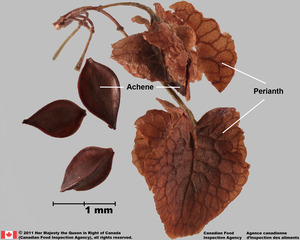 persistent, with many seeds. Pericarppericarp:
persistent, with many seeds. Pericarppericarp:
fruit wall or fruit coat
white, yellow, brown, black, green, orange, or red, shinyshiny:
uniformly reflecting a high proportion of incident light at all angles or dulldull:
or dulldull:
reflecting only a low proportion of incident light, with no apparent sheen , membranousmembranous:
, membranousmembranous:
texture—extremely thin, pliable, and fairly tough
, crustaceouscrustaceous:
texture—thin, dry, indurate, and brittle
, fleshy, leatheryleathery:
texture—moderately thick, tough, and very pliable
, or woodywoody:
texture—consisting mainly of indurate lignified tissues, characteristic of or resembling wood
, smooth, ribbedribbed:
surface relief—wide, prominent, linear ridges that are generally rounded and longitudinally situated on the surface , ridgedridged:
, ridgedridged:
surface relief—raised, thick ridges, sharp edged or rounded, usually in a series that may cover the entire surface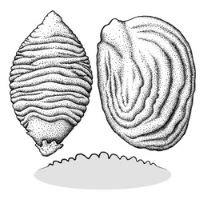 , papillatepapillate:
, papillatepapillate:
surface relief—bearing minute, distinct, broad-based projections, tapering to a rounded apex , scalyscaly:
, scalyscaly:
surface relief—covered with small, thin, fine scales or flakes that may be removable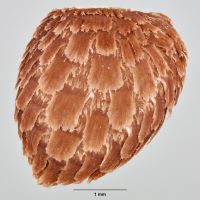 , wartywarty:
, wartywarty:
surface relief—distinct, rounded projections that are large relative to the fruit size; tuberculate, verrucose , or spinyspiny:
, or spinyspiny:
having slender, stiff, sharp projections oriented in the general plane of the structure , sometimes pubescentpubescent:
, sometimes pubescentpubescent:
surface relief—bearing hairs
, sometimes with glandularglandular:
surface relief—covered with small, raised secretory glands, regular or irregularly shaped, translucent or opaque, and maybe distinctly colored hairs.
hairs.
Seeds globoseglobose:
3D shape—more or less spherical to fusiformfusiform:
to fusiformfusiform:
spindle-shaped; broadest at the middle and tapering at both ends , 0.5–1.4 mm long, with or without caudatecaudate:
, 0.5–1.4 mm long, with or without caudatecaudate:
tapering to a long, tail-like appendage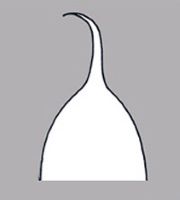 appendage(s). Seed coat brown or black, dulldull:
appendage(s). Seed coat brown or black, dulldull:
reflecting only a low proportion of incident light, with no apparent sheen , loose, hard and thin, alveolatealveolate:
, loose, hard and thin, alveolatealveolate:
surface relief—reticulated, honeycombed; ridges that intersect to form polygonal cells with a regular size and shape similar to a honeycomb , reticulatereticulate:
, reticulatereticulate:
surface relief—netted, raised walls or concave grooves forming a net-like surface pattern with flat, concave, or convex interspaces , wartywarty:
, wartywarty:
surface relief—distinct, rounded projections that are large relative to the fruit size; tuberculate, verrucose , pittedpitted:
, pittedpitted:
surface relief—surface with small depressions in which the areas between the hollows do not take on the appearance of a true reticular net or papillatepapillate:
or papillatepapillate:
surface relief—bearing minute, distinct, broad-based projections, tapering to a rounded apex .
.
Embryo rudimentaryrudimentary:
(of embryo) embryo is small and fills less than a quarter of the seed and can be variable in shapes, such as linear, spatulate, or oval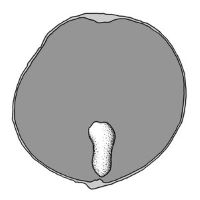 , minute, filling the seed coat, usually chlorophyllous.
, minute, filling the seed coat, usually chlorophyllous.
Endosperm lacking.
| Fruit | |
| Type | capsulecapsule: a dry, dehiscent fruit derived from a compound ovary  , rarely a berryberry: , rarely a berryberry:an indehiscent, fleshy fruit with one or a few to many seeds. The flesh may be homogenous throughout. Or, if the outer part is hard, firm, or leathery, referred to as an hesperidium. Septa are present in some, and the seeds may be arillate or with a fleshy testa. 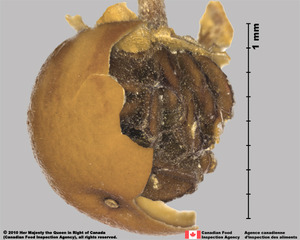 |
| Size range | 3–270 mm long |
| Shape(s) | ellipsoidellipsoid: 3D shape—elliptic , oblongoblong: 2D shape—much longer than broad with nearly parallel sides, corners are rounded  , fusiformfusiform: , fusiformfusiform:spindle-shaped; broadest at the middle and tapering at both ends  , cuneiformcuneiform: , cuneiformcuneiform:wedge-shaped , cylindricalcylindrical: 3D shape—a cylinder, with parallel sides and a circular cross-section; tubular or rod-shaped , trigonoustrigonous: 3D shape—having three faces that meet at distinct angles; triangular in outline , globoseglobose: 3D shape—more or less spherical  , ovoidovoid: , ovoidovoid:3D shape—ovate  , lanceoloidlanceoloid: , lanceoloidlanceoloid:3D shape—lanceolate , conicalconical: 3D shape—cone-shaped, with the point of attachment at the broad end 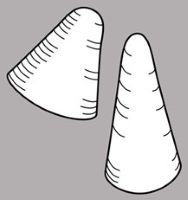 , teardrop-shapedteardrop-shaped: , teardrop-shapedteardrop-shaped:2D shape—widest point is toward one end of the fruit, the other end tapers sharply to a pointed end 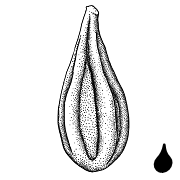 |
| Texture | crustaceouscrustaceous: texture—thin, dry, indurate, and brittle , fleshy, leatheryleathery: texture—moderately thick, tough, and very pliable , membranousmembranous: texture—extremely thin, pliable, and fairly tough , woodywoody: texture—consisting mainly of indurate lignified tissues, characteristic of or resembling wood |
| Surface relief | sulcatesulcate: surface relief—having one or more elongate, relatively narrow and shallow depressions or grooves  , smooth, wartywarty: , smooth, wartywarty:surface relief—distinct, rounded projections that are large relative to the fruit size; tuberculate, verrucose  , ribbedribbed: , ribbedribbed:surface relief—wide, prominent, linear ridges that are generally rounded and longitudinally situated on the surface  , ridgedridged: , ridgedridged:surface relief—raised, thick ridges, sharp edged or rounded, usually in a series that may cover the entire surface  , spinyspiny: , spinyspiny:having slender, stiff, sharp projections oriented in the general plane of the structure  , papillatepapillate: , papillatepapillate:surface relief—bearing minute, distinct, broad-based projections, tapering to a rounded apex  , scalyscaly: , scalyscaly:surface relief—covered with small, thin, fine scales or flakes that may be removable  |
| Color(s) | white, yellow, brown, black, green, orange, red |
| Unique features | Usually sulcatesulcate: surface relief—having one or more elongate, relatively narrow and shallow depressions or grooves  and/or sculptured capsulescapsule: and/or sculptured capsulescapsule:a dry, dehiscent fruit derived from a compound ovary  , dehiscing by 3 (or 6) hygroscopically sensitive valves, with many dustlike to small seeds. , dehiscing by 3 (or 6) hygroscopically sensitive valves, with many dustlike to small seeds. |
| Seed | |
| Size range | 0.5–1.4 mm long |
| Shape(s) | polygonalpolygonal: angular , fusiformfusiform: spindle-shaped; broadest at the middle and tapering at both ends  , ovoidovoid: , ovoidovoid:3D shape—ovate  , ellipsoidellipsoid: , ellipsoidellipsoid:3D shape—elliptic , oblongoblong: 2D shape—much longer than broad with nearly parallel sides, corners are rounded  , cylindricalcylindrical: , cylindricalcylindrical:3D shape—a cylinder, with parallel sides and a circular cross-section; tubular or rod-shaped , globoseglobose: 3D shape—more or less spherical  , lens-shapedlens-shaped: , lens-shapedlens-shaped:2D shape—round and flattened with two curved (convex) surfaces |
| Surface relief | alveolatealveolate: surface relief—reticulated, honeycombed; ridges that intersect to form polygonal cells with a regular size and shape similar to a honeycomb  , reticulatereticulate: , reticulatereticulate:surface relief—netted, raised walls or concave grooves forming a net-like surface pattern with flat, concave, or convex interspaces  , wartywarty: , wartywarty:surface relief—distinct, rounded projections that are large relative to the fruit size; tuberculate, verrucose  , pittedpitted: , pittedpitted:surface relief—surface with small depressions in which the areas between the hollows do not take on the appearance of a true reticular net  , papillatepapillate: , papillatepapillate:surface relief—bearing minute, distinct, broad-based projections, tapering to a rounded apex  |
| Color(s) | brown, black |
| Unique features | Dustlike to small, brown or black, fusiformfusiform: spindle-shaped; broadest at the middle and tapering at both ends  seeds with a loose membranousmembranous: seeds with a loose membranousmembranous:texture—extremely thin, pliable, and fairly tough seed coat sometimes forming an appendage. |
| Other | |
| Embryo | rudimentaryrudimentary: (of embryo) embryo is small and fills less than a quarter of the seed and can be variable in shapes, such as linear, spatulate, or oval  , minute, filling the seed coat, usually chlorophyllous , minute, filling the seed coat, usually chlorophyllous |
| Nutritive tissue | endosperm lacking |
Nearly worldwide.
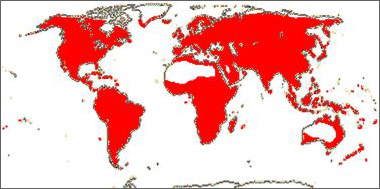
Distribution map courtesy of Angiosperm Phylogeny Website.
Baskin and Baskin 2021Baskin and Baskin 2021:
Baskin C and Baskin J. 2021. Relationship of the lateral embryo (in grasses) to other monocot embryos: A status up-grade. Seed Science Research 31 (3): 199-210. doi:10.1017/S0960258521000209; Dahlgren et al. 1985Dahlgren et al. 1985:
Dahlgren RMT, Clifford HT, and Yeo PF. 1985. The families of the monocotyledons: structure, evolution, and taxonomy. Springer-Verlag, Berlin. 520 pp.; Davidse et al. 2009–2018Davidse et al. 2009–2018:
Davidse GM, Sousa Sánchez M, Knapp S. and Chiang Cabrera F, eds. 2009–2018. Flora Mesoamericana. Missouri Botanical Garden, St. Louis, MO. Accessed: January–April 2024. URL: http://legacy.tropicos.org/Project/FM; Flora of North America Editorial Committee 1993+Flora of North America Editorial Committee 1993+:
Flora of North America Editorial Committee, eds. 1993+. Flora of North America North of Mexico [Online]. 22+ vols. Flora of North America Association, New York and Oxford. Accessed January-March 2024. URL: http://beta.floranorthamerica.org.; Kirkbride et al. 2006Kirkbride et al. 2006:
Kirkbride JH, Jr, Gunn CR, and Dallwitz MJ. 2006. Family guide for fruits and seeds, vers. 1.0. Accessed September 2020-January 2022. URL: https://nt.ars-grin.gov/seedsfruits/keys/frsdfam/index.cfm .; Stevenson and Loconte 1995Stevenson and Loconte 1995:
Stevenson DW and Loconte H. 1995. A cladistic analysis of monocot families. In: Rudall PJ, Cribb PJ, Cutler DF, and Humphries CJ, eds. Monocotyledons: Systematics and Evolution. Royal Botanic Gardens, Kew.; Summerhayes 1968Summerhayes 1968:
Summerhayes VS. 1968. Orchidaceae (Part 1). In: Milne-Redhead E and Polhill RM, eds. Flora of Tropical East Africa. Crown Agents for Oversea Governments and Administrations, London UK. 235 pp.; Takhtajan 1997Takhtajan 1997:
Takhtajan A. 1997. Diversity and Classification of Flowering Plants. Columbia University Press, New York. 643 pp.; Zhengyi et al. 2004+Zhengyi et al. 2004+:
Zhengyi W, Raven PH, and Deyuan H. 2004+. Flora of China [online]. 25 vols. Science Press, Beijing China & Missouri Botanical Garden, St. Louis USA. Accessed January–March 2024. http://flora.huh.harvard.edu/china/
*The number of genera and species is based on Christenhusz and Byng 2016Christenhusz and Byng 2016:
Christenhusz MJM and Byng JW. 2016. The number of known plant species in the world and its annual increase. Phytotaxa 261 (3): 201-217. https://doi.org/10.11646/phytotaxa.261.3.1, which may differ from the number of genera in GRIN-Global.